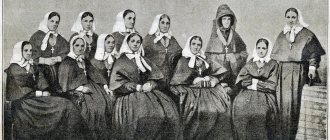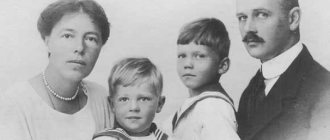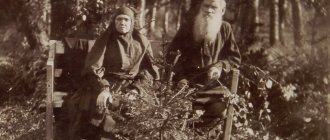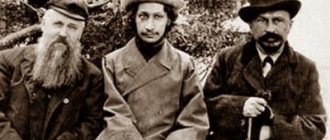| FULL NAME: | Romanova Elizaveta Fedorovna (Elizabeth Alexandra Louise Alice of Hesse-Darmstadt) |
| Date of Birth: | 01.11.1864 |
| Place of Birth: | Darmstadt, Germany |
| Zodiac sign: | Scorpion |
| Activity: | Princess, princess |
| Date of death: | 18.07.1918 (53 years old) |
Elizaveta Fedorovna Romanova (Elizabeth Alexandra Louise Alice of Hesse-Darmstadt at birth) is a Grand Duchess of Russia , German by birth. Wife of Prince Sergei Alexandrovich Romanov . She was killed by the Bolsheviks along with the rest of the ruling family.
Not so simple bride
The decision to marry was made at a difficult time for Grand Duke Sergei Alexandrovich: in the summer of 1880, his mother, Maria Alexandrovna, whom he adored, died, and less than a year later, a bomb from Narodnaya Volya member Ignatius Grinevitsky ended the life of his father, Emperor Alexander II. The time has come for him to remember the words of his teacher, maid of honor Anna Tyutcheva, who wrote to the young prince: “By your nature, you should be married, you suffer alone.” Sergei Alexandrovich really had the unfortunate tendency to delve into himself and engage in self-criticism. He needed a loved one... And he found such a person.
Grand Duke Sergei Alexandrovich. 1861
1884 Ella is one of the most beautiful brides in Europe. Sergei is one of the most eligible bachelors, the fifth son of Emperor Alexander II the Liberator. Judging by the diaries, they first met when the Grand Duchess of Hesse and Rhine Alice-Maude-Mary, wife of Ludwig IV, was in the last months of pregnancy with the future wife of the Grand Duke. A photograph has been preserved where she sits with the Russian Empress Maria Alexandrovna, who came to Darmstadt, and her seven-year-old son Sergei. When the Russian crowned family returned to Russia from their trip to Europe, they again visited relatives in Darmstadt, and the little Grand Duke was allowed to be present at the bathing of the newborn Ella, his future wife.
Why Sergei made a choice in favor of Elizabeth escaped the attention of his family and educators. But the choice was made! And although Ella and Sergei both had doubts, in the end, in 1883, their engagement was announced to the world. “I gave my consent without hesitation,” Ella’s father, Grand Duke Ludwig IV, said then. — I have known Sergei since childhood; I see his sweet, pleasant manners and I’m sure that he will make my daughter happy.”
Princess Ella of Hesse and Great Britain. Early 1870s
The son of the Russian emperor married a provincial German duchess! This is the usual view of this brilliant couple - and also a myth. The Darmstadt duchesses were not so simple. Elizabeth and Alexandra (who became the last Russian empress) are the granddaughters of Queen Victoria, from the age of 18 until her death in old age, the permanent ruler of Great Britain (Empress of India from 1876!), a person of strict morality and the iron grip with which Britain achieved its heyday The official title of Elizabeth Feodorovna, which passed to all Hessian princesses, was Duchess of Great Britain and the Rhine: they belonged, no more and no less, to the family that at that time ruled a third of the land. And this title - according to all the rules of etiquette - was inherited from their mother, Empress Alexandra Feodorovna, the daughter of the last Russian Emperor Nicholas II.
Thus, the Romanovs became related to the British crown thanks to Alice of Hesse - like her mother Victoria, an unusually strong woman: having married a German duke, Alice was forced to face the fastidiousness of the Germans, who were not very willing to accept the English princess. Nevertheless, she once headed parliament for nine months; launched extensive charitable activities - the almshouses she founded operate in Germany to this day. Ella also inherited her acumen, and subsequently her character will make itself felt.
In the meantime, Elizabeth of Darmstadt, although an extremely noble and educated, but somewhat flighty and impressionable young lady, discusses shops and beautiful trinkets. Preparations for her wedding with Sergei Alexandrovich were kept in the strictest confidence, and in the summer of 1884, the nineteen-year-old Hessian princess arrived in the capital of the Russian Empire on a train decorated with flowers.
“He often treated her like a school teacher...”
In public, Elizaveta Fedorovna and Sergei Alexandrovich were, first of all, high-ranking persons, they headed societies and committees, and their human relations, their mutual love and affection were kept secret. Sergei Alexandrovich made every effort to ensure that the internal life of the family did not become public knowledge: he had many ill-wishers. From the letters we know more than the Romanov contemporaries could know.
“He told me about his wife, admired her, praised her. He thanks God every hour for his happiness,” recalls Prince Konstantin Konstantinovich, his relative and close friend. The Grand Duke really adored his wife - he loved to give her extraordinary jewelry, give her small gifts with or without any reason. Treating her strictly at times, in her absence he could not praise Elizabeth enough. As one of his nieces (future Queen Maria of Romania) recalls, “my uncle was often harsh with her, as with everyone else, but he worshiped her beauty. He often treated her like a school teacher. I saw the delicious flush of shame that washed over her face when he scolded her. “But, Serge...” she exclaimed then, and the expression on her face was like the face of a student caught in some mistake.”
“I felt how Sergei desired this moment; and I knew many times that he suffered from it. He was a real angel of kindness. How often could he, by touching my heart, lead me to a change of religion in order to make himself happy; and he never, never complained... Let people shout about me, but just never say a word against my Sergei. Take his side before them and tell them that I adore him, as well as my new country, and that in this way I have learned to love their religion ... "
From a letter from Elizabeth Feodorovna to her brother Ernest about changing religion
Contrary to the rumors spread at the time, it was a truly happy marriage. On the day of the tenth anniversary of their married life, which occurred at the height of the Russo-Japanese War, the prince wrote in his diary: “In the morning I’m in church, my wife is in the warehouse*. Lord, why am I so happy?” (A donation warehouse for the benefit of soldiers, organized with the assistance of Elizabeth Feodorovna: clothes were sewn there, bandages were prepared, parcels were collected, camp churches were formed. - Ed.)
Their life was truly a service with the maximum dedication of all their strength and abilities, but we will have time to talk about this. What is she? In a letter to her brother Ernest, Ella calls her husband “a real angel of kindness.”
The Grand Ducal couple visiting their Darmstadt relatives. Grand Duchess Elizaveta Feodorovna is second from the right; second from left - Princess Alice, future Empress Alexandra Feodorovna
The Grand Duke became in many ways a teacher to his wife, very gentle and unobtrusive. Being 7 years older, he is really involved in her education to a large extent, teaching her Russian language and culture, introducing her to Paris, showing her Italy and taking her on a trip to the Holy Land. And, judging by the diaries, the Grand Duke did not stop praying, hoping that someday his wife would share with him the main thing in his life - his faith and the Sacraments of the Orthodox Church, to which he belonged with all his soul.
“After 7 long years of our happy married life <...> we must start a completely new life and leave our cozy family life in the city. We will have to do so much for the people there, and in reality we will play the role of a ruling prince there, which will be very difficult for us, since instead of playing such a role, we are eager to lead a quiet private life.
From a letter from Elizabeth Feodorovna to her father, the Grand Duke of Hesse, about the appointment of her husband to the post of Governor General of Moscow
Extraordinary religiosity is a trait that distinguished the Grand Duke from childhood. When seven-year-old Sergei was brought to Moscow and asked: what would you like? — he replied that his most cherished desire was to attend the bishop’s service in the Assumption Cathedral of the Kremlin.
Sergei Alexandrovich and Elizaveta Fedorovna in the Holy Land. Gethsemane, Church of St. Mary Magdalene, 1888
Subsequently, when as an adult young man he met Pope Leo XIII during a trip to Italy, he was amazed at the Grand Duke’s knowledge of church history - and even ordered to open the archives to check the facts voiced by Sergei Alexandrovich. Entries in his diaries always began and ended with the words: “Lord, have mercy,” “Lord, bless.” He himself decided what church utensils should be brought to the consecration of the Church of St. Mary Magdalene in Gethsemane (also his brainchild) - brilliantly knowing both the divine service and all its paraphernalia! And, by the way, Sergei Alexandrovich was the first and only of the great princes of the Romanov dynasty who made a pilgrimage to the Holy Land three times during his life. Moreover, he dared to do the first through Beirut, which was extremely difficult and far from safe. And the second time he took his wife with him, who was still a Protestant at that time...
Where are the relics of the Grand Duchess buried?
In 1921, the remains of Grand Duchess Elisaveta Feodorovna and nun Varvara were taken to Jerusalem. There they found peace in the tomb of the Church of St. Mary Magdalene, Equal to the Apostles, in Gethsemane. In 1931, on the eve of the canonization of the Russian new martyrs by the Russian Orthodox Church Outside of Russia, they decided to open the tombs of the martyrs. The autopsy was supervised by a commission headed by the head of the Russian Ecclesiastical Mission, Archimandrite Anthony (Grabbe). When they opened the coffin with the body of the Grand Duchess, the whole room was filled with fragrance. According to Archimandrite Anthony, there was a “strong smell, as if of honey and jasmine.” The relics, which turned out to be partially incorrupt, were transferred from the tomb to the church of St. Mary Magdalene itself.
“Being of the same faith with your spouse is right”
In their family estate Ilyinsky, where Sergei Alexandrovich and Elizaveta Fedorovna spent the happiest days of their lives, starting with their honeymoon, a temple has been preserved, and now it is operating again. According to legend, it was here that the then Protestant Ella attended her first Orthodox service.
Grand Duchess Elizaveta Feodorovna painting. Late 1880s
Due to her status, Elizaveta Fedorovna did not have to change her religion. 7 years would pass after her marriage before she wrote: “My heart belongs to Orthodoxy.” Evil tongues said that Elizaveta Fedorovna was actively pushed to accept the new faith by her husband, under whose unconditional influence she was always. But, as the Grand Duchess herself wrote to her father, her husband “never tried to force me by any means, leaving all this entirely to my conscience.” All he did was gently and delicately introduce her to his faith. And the princess herself approached this issue very seriously, studying Orthodoxy, looking at it very carefully.
Elizaveta Fedorovna infirmary in Ilyinsky. 1906
Having finally made a decision, Ella first writes to her influential grandmother Queen Victoria - they have always been on good terms. The wise grandmother replies: “Being with your spouse of the same faith is right.” Her father did not accept Elizaveta Fedorovna’s decision so favorably, although it is difficult to imagine a more affectionate and tactful tone and more sincere words with which Ella begged the “dear Pope” for his blessing on the decision to convert to Orthodoxy:
Palace in Ilyinsky. 1900s
“... I kept thinking and reading and praying to God to show me the right path, and I came to the conclusion that only in this religion can I find all the real and strong faith in God that a person must have in order to be a good Christian. It would be a sin to remain as I am now - to belong to the same Church in form and for the outside world, but inside myself to pray and believe the same way as my husband ‹…› I so strongly wish for Easter to partake of the Holy Mysteries together with my husband..."
Duke Ludwig IV did not answer his daughter, but she could not go against her conscience, although she admitted: “I know that there will be many unpleasant moments, since no one will understand this step.” So, to the indescribable happiness of the spouse, the day came when they were able to take communion together. And the third, last in his life, trip to the Holy Land had already been made together - in every sense.
Childhood and youth
Elizaveta Feodorovna was born on November 1, 1864 in the city of Darmstadt in the family of the Duke of Hesse-Darmstadt Ludwig IV and the daughter of Queen Victoria of England - Princess Alice . Elizabeth (Ella), together with her older sister Alice (after her marriage, Alexandra Feodorovna), were raised as future princesses in their grandmother's house, were religious, learned housekeeping and took part in charitable events.
In early childhood
Initially, her cousin Frederick of Baden , but the engagement never took place. Also, according to rumors, another cousin, the future Prussian King William II, proposed marriage to the Princess of Hesse-Darmstadt, but Elizabeth rejected this proposal.
Elizabeth in her youth
"White marriage" that never happened
It is generally accepted that Sergei and Elizabeth deliberately entered into a so-called “white marriage”: they decided not to have children, but to devote themselves to serving God and people. Memoirs of loved ones and diaries indicate otherwise.
“How I would like to have children! For me there would be no greater heaven on earth if I had my own children,” Sergei Alexandrovich writes in his letters. A letter from Emperor Alexander III to his wife, Empress Maria Feodorovna, has been preserved, where he writes: “What a pity that Ella and Sergei cannot have children.” “Of all the uncles, we were most afraid of Uncle Sergei, but despite this, he was our favorite,” Prince Maria’s niece recalls in her diaries. “He was strict, he kept us in awe, but he loved children... If he had the opportunity, he came to supervise the children’s bathing, cover them with a blanket and kiss them goodnight...”
The spouses are Grand Duke Sergei Alexandrovich and Grand Duchess Elizaveta Feodorovna. 1884
The Grand Duke was given the opportunity to raise children - but not his own, but his brother Paul, after the tragic death of his wife, the Greek princess Alexandra Georgievna, during premature birth. The owners of the estate, Sergei and Elizaveta, were direct witnesses to the six-day agony of the unfortunate woman. Heartbroken, Pavel Alexandrovich, for several months after the tragedy, was unable to care for his children - young Maria and newborn Dmitry, and Grand Duke Sergei Alexandrovich completely took upon himself this care. He canceled all plans and trips and stayed in Ilyinsky, participated in bathing the newborn - who, by the way, should not have survived according to the unanimous opinion of the doctors - he himself covered him with cotton wool, did not sleep at night, taking care of the little prince. It is interesting that in his diary Sergei Alexandrovich recorded all the important events in the life of his ward: the first erupted tooth, the first word, the first step. And after brother Pavel, against the will of the emperor, married a woman who did not belong to an aristocratic family and was expelled from Russia, his children, Dmitry and Maria, were finally taken into the care of Sergei and Elizabeth.
Why the Lord did not give the spouses their own children is His mystery. Researchers suggest that the childlessness of the grand ducal couple could be a consequence of Sergei’s serious illness, which he carefully hid from those around him. This is another little-known page in the prince’s life, which completely changes the usual ideas about him for many.
Marfo-Mariinskaya Convent
After the death of her husband at the hands of a terrorist, Elisaveta Feodorovna began to lead an almost monastic lifestyle. Her house became like a cell, she did not take off her mourning, did not attend social events. She prayed in the temple and observed strict fasting. She sold part of her jewelry (giving to the treasury that part that belonged to the Romanov dynasty), and with the proceeds she bought an estate on Bolshaya Ordynka with four houses and a vast garden, where the Marfo-Mariinskaya Convent of Mercy, founded by her in 1909, was located. There were two temples, a large garden, a hospital, an orphanage and much more. The first church in the monastery was consecrated in the name of the holy myrrh-bearing women Martha and Mary, the second - in honor of the Intercession of the Most Holy Theotokos. In the Martha and Mary Convent of Mercy, the charter of the monastery hostel was in effect. In 1910, Bishop Tryphon (Turkestan) ordained 17 nuns to the title of Cross Sisters of Love and Mercy, and the Grand Duchess to the rank of abbess. Archpriest Mitrofan Serebryansky became the confessor of the monastery. The abbess herself led an ascetic life. She fasted, slept on a hard bed, got up for prayer even before dawn, worked until late in the evening: distributed obediences, attended operations in the clinic, and conducted administrative affairs of the monastery. Elisaveta Feodorovna was a supporter of the revival of the rank of deaconesses - ministers of the church of the first centuries, who in the first centuries of Christianity were appointed through ordination, participated in the celebration of the Liturgy, approximately in the role in which subdeacons now serve, were engaged in catechesis of women, helped with the baptism of women, and served the sick. She received the support of the majority of members of the Holy Synod on the issue of conferring this title on the sisters of the monastery, however, in accordance with the opinion of Nicholas II, the decision was never made. When creating the monastery, both Russian Orthodox and European experience were used. The sisters who lived in the monastery took vows of chastity, non-covetousness and obedience, however, unlike the nuns, after a certain period of time, the charter of the monastery allowed the sisters to leave it and start a family. “The vows that the sisters of mercy made at the monastery were temporary (for one year, three, six, and only then for life), so, although the sisters led a monastic lifestyle, they were not nuns. The sisters could leave the monastery and get married, but if they wished, they could also be tonsured into the mantle, bypassing monasticism.” (Ekaterina Stepanova, Martha and Mary Convent: a unique example, article from the Neskuchny Garden magazine on the Orthodoxy and World website). “Elizabeth wanted to combine social service and strict monastic rules. To do this, she needed to create a new type of women's church ministry, something between a monastery and a sisterhood. Secular sisterhoods, of which there were many in Russia at that time, did not please Elisaveta Feodorovna for their secular spirit: sisters of mercy often attended balls, led an overly secular lifestyle, and she understood monasticism exclusively as contemplative, prayerful work, complete renunciation of the world (and, accordingly, work in hospitals, hospitals, etc.).” (Ekaterina Stepanova, Marfo-Mariinskaya Convent: a unique example, article from the magazine “Neskuchny Sad” on the website “Orthodoxy and the World”) The sisters received serious psychological, methodological, spiritual and medical training at the monastery. They were given lectures by the best doctors in Moscow, conversations with them were conducted by the confessor of the monastery, Fr. Mitrofan Srebryansky (later Archimandrite Sergius; canonized by the Russian Orthodox Church) and the second priest of the monastery, Fr. Evgeny Sinadsky.
Elisaveta Feodorovna dressed as a sister of the Marfo-Mariinsky Convent
According to Elisaveta Feodorovna’s plan, the monastery was supposed to provide comprehensive, spiritual, educational and medical assistance to those in need, who were often not only given food and clothing, but helped in finding employment and placed in hospitals. Often the sisters persuaded families who could not give their children a normal upbringing (for example, professional beggars, drunkards, etc.) to send their children to an orphanage, where they were given an education, good care and a profession. A hospital, an excellent outpatient clinic, a pharmacy where some medications were provided free of charge, a shelter, a free canteen and many other institutions were created in the monastery. Educational lectures and conversations, meetings of the Palestine Society, Geographical Society, spiritual readings and other events were held in the Intercession Church of the monastery. Having settled in the monastery, Elisaveta Feodorovna led an ascetic life: at night caring for the seriously ill or reading the Psalter over the dead, and during the day she worked, along with her sisters, going around the poorest neighborhoods. Together with her cell attendant Varvara Yakovleva, Elisaveta Feodorovna often visited the Khitrov market, a place of attraction for the Moscow poor. Here mother found street children and sent them to city shelters. All of Khitrovka respectfully called the Grand Duchess “sister Elizabeth” or “mother.” She maintained relations with a number of famous elders of that time: Schema-Archimandrite Gabriel (Zyryanov) (Eleazar Hermitage), Schema-Abbot Herman (Gomzin) and Hieroschemamonk Alexy (Solovyov) (Elders of Zosimova Hermitage). Elisaveta Feodorovna did not take monastic vows. During the First World War, she actively took care of helping the Russian army, including wounded soldiers. At the same time, she tried to help prisoners of war, with whom the hospitals were overcrowded and, as a result, was accused of collaborating with the Germans. With her participation, at the beginning of 1915, a workshop was organized to assemble prosthetics from ready-made parts, mostly obtained from the St. Petersburg Military Medical Manufacturing Plant, where there was a special prosthetic workshop. Until 1914, this industry did not develop in Russia. Funds for equipping the workshop, located on private property at No. 9 Trubnikovsky Lane, were collected from donations. As military operations progressed, the need to increase the production of artificial limbs increased and the Grand Duchess Committee moved production to Maronovsky Lane, 9. Understanding the full social significance of this direction, with the personal participation of Elisaveta Feodorovna in 1916, work began on the design and construction of the first in Moscow Russian prosthetic plant, which is still producing components for prosthetics.
Marfo-Mariinskaya Convent of Mercy. Moscow, end of the 19th century.
Elisaveta Feodorovna wanted to open branches of the monastery in other cities of Russia, but her plans were not destined to come true. The First World War began, with the blessing of Mother, the sisters of the monastery worked in field hospitals. Revolutionary events affected all members of the Romanov dynasty, even Grand Duchess Elizabeth, who was loved by all of Moscow. Soon after the February Revolution, an armed crowd with red flags came to arrest the abbess of the monastery - “a German spy who keeps weapons in the monastery.” The monastery was searched; After the crowd left, Elisaveta Feodorovna said to the sisters: “Obviously we are not yet worthy of the crown of martyrdom.” After the October Revolution of 1917, the monastery was not disturbed at first; they even brought food and medicine to the sisters. The arrests began later. In 1918, Elisaveta Feodorovna was taken into custody. The Marfo-Mariinskaya Convent existed until 1926. Some sisters were sent into exile, others united into a community and created a small vegetable garden in the Tver region. Two years later, a cinema was opened in the Church of the Intercession, and then a house of health education was located there. A statue of Stalin was placed in the altar. After the Great Patriotic War, the State Art Restoration Workshops settled in the monastery cathedral; the remaining premises were occupied by a clinic and laboratories of the All-Union Institute of Mineral Raw Materials. In 1992, the territory of the monastery was transferred to the Russian Orthodox Church. Now the monastery lives according to the charter created by Elisaveta Feodorovna. The nuns are trained at the St. Demetrius School of Sisters of Mercy, help those in need, work in the newly opened shelter for orphan girls on Bolshaya Ordynka, a charity canteen, a patronage service, a gymnasium and a cultural and educational center.
Sculptural portrait of Elizabeth Feodorovna by Pavel Trubetskoy, 1899
Statues of 20th century martyrs on the west façade of Westminster Abbey: Maximilian Kolbe, Manche Masemola, Janani Luwum, Grand Duchess Elizabeth Feodorovna, Martin Luther King, Oscar Romero, Dietrich Bonhoeffer, Esther John, Lucian Tapiedi and Wang Zhiming
Why does he need a corset?
Coldness of character, isolation, closedness - the usual list of accusations against the Grand Duke.
To this they also add: proud! - because of his overly straight posture, which gave him an arrogant appearance. If only the prince’s accusers knew that the “culprit” of his proud posture was the corset with which he was forced to support his spine all his life. The prince was seriously and terminally ill, like his mother, like his brother Nikolai Alexandrovich, who was supposed to become the Russian emperor, but died from a terrible illness. Grand Duke Sergei Alexandrovich knew how to hide his diagnosis - bone tuberculosis, leading to dysfunction of all joints. Only his wife knew what it cost him.
“Sergei is suffering a lot. He's not feeling well again. He really needs salts and hot baths, he can’t do without them,” Elizaveta writes to close relatives. “Instead of going to the reception, the Grand Duke took a bath,” the Moskovskie Vedomosti newspaper scoffed already in pre-revolutionary times. A hot bath is almost the only remedy that relieves pain (joint pain, dental pain) that tormented Sergei Alexandrovich. He could not ride a horse, could not do without a corset. In Ilyinsky, during his mother’s lifetime, a kumys farm was established for medicinal purposes, but the disease progressed over the years. And if it weren’t for the bomb of student Ivan Kalyaev, it is very possible that the Governor General of Moscow would not have lived long anyway...
The Grand Duke was closed, taciturn and withdrawn from childhood. Could anyone expect anything different from a child whose parents were actually in a divorce, which nevertheless could not take place? Maria Alexandrovna lived on the second floor of the Winter Palace, no longer having marital communication with her husband and enduring the presence of the sovereign’s favorite, Princess Dolgorukova (she became his wife after the death of Maria Alexandrovna, but remained in this status for less than a year, until the death of Alexander II). The collapse of the parental family, the deep attachment to the mother, who meekly endured this humiliation, are factors that largely determined the formation of the character of the little prince.
They are also grounds for slander, rumors and slander against him. “He is overly religious, withdrawn, goes to church very often, takes communion up to three times a week,” this is the most “suspicious” of what English intelligence was able to find out about the prince before his marriage to Elizabeth, after all - granddaughter of the Queen of England. His reputation is almost impeccable, and yet, even during his lifetime, the Grand Duke was subjected to streams of slander and unflattering accusations...
Prayers
Troparion of the Prmc. led book Elizabeth, voice 1
By humility you hid your princely dignity, / the godly Elisaveto, / through the deep service of Martha and Mary, / you honored Christ. / By mercy, patience and love, you chose to honor yourself, / like a sacrifice you have offered yourself to God as a righteous woman, / but we, who honor your virtuous life and suffering, / as We earnestly ask you to be a true mentor:/ Holy Martyr Grand Duchess Elizabeth, // pray to Christ God to save and enlighten our souls.
Kontakion prmts. led book Elizabeth, voice 2
Who tells the story of the greatness of the feat of faith: / in the depths of the earth, as in heaven of lordship, / the passion-bearer Grand Duchess Elizabeth / with the angels rejoicing in psalms and songs / and enduring murder ,/ crying out for the godless tormentors:/ Lord, forgive them this sin,/ They don’t know what they are doing./ Through your prayers, O Christ God, // have mercy and save our souls.
“Be patient - you are on the battlefield”
There was talk about the dissolute lifestyle of the Governor-General of Moscow, rumors were spread around the capital about his unconventional sexual orientation, that Elizaveta Feodorovna was very unhappy in her marriage to him - all this was even heard in English newspapers during the prince’s lifetime. Sergei Alexandrovich was at first lost and perplexed, this can be seen from his diary entries and letters, where he poses one question: “Why? Where does all this come from?!”
“Be patient with all this lifetime slander, be patient—you’re on the battlefield,” Grand Duke Konstantin Konstantinovich wrote to him.
Elizaveta Feodorovna could not avoid attacks and accusations of arrogance and indifference. Of course, there were reasons for this: despite her extensive charitable activities, she always kept her distance, knowing the value of her status as a Grand Duchess - belonging to the imperial house hardly implies familiarity. And her character, which manifested itself from childhood, gave rise to such accusations.
In our eyes, the image of the Grand Duchess, admittedly, is somewhat unctuous: a gentle, meek woman with a humble look. This image was formed, of course, not without reason. “Her purity was absolute, it was impossible to take your eyes off her, after spending the evening with her, everyone looked forward to the hour when they could see her the next day,” her niece Maria admires Aunt Ella. And at the same time, one cannot help but notice that Grand Duchess Elizabeth had a strong-willed character. The mother admitted that Ella was the exact opposite of her older, obedient sister Victoria: very strong and not at all quiet. It is known that Elizabeth spoke very harshly about Grigory Rasputin, believing that his death would be the best way out of the catastrophic and absurd situation that had developed at court.
“...When he saw her <...>, he asked: “Who are you?” “I am his widow,” she replied, “why did you kill him?” “I didn’t want to kill you,” he said, “I saw him several times while I had the bomb ready, but you were with him and I didn’t dare touch him.” “And you didn’t realize that you killed me along with him?” - she answered..."
Description of Elizabeth Feodorovna’s conversation with her husband’s killer from the book by Fr. M. Polsky “New Russian Martyrs”
As they would say today, the Grand Duchess was a first-class manager, meticulously able to organize a business, distribute responsibilities and monitor their implementation. Yes, she behaved somewhat aloof, but at the same time she did not ignore the slightest requests and needs of those who turned to her. There is a known case during the First World War when a wounded officer, who was facing amputation of his leg, submitted a request to reconsider this decision. The petition reached the Grand Duchess and was granted. The officer recovered and subsequently, during World War II, served as Minister of Light Industry.
Of course, Elizaveta Fedorovna’s life changed dramatically after a terrible event - the murder of her beloved husband... A photograph of a carriage destroyed by an explosion was then published in all Moscow newspapers. The explosion was so strong that the heart of the murdered man was found only on the third day on the roof of the house. But the Grand Duchess collected the remains of Sergei with her own hands. Her life, her destiny, her character - everything has changed, but, of course, her entire previous life, full of dedication and activity, was a preparation for this.
“It seemed,” recalled Countess Alexandra Andreevna Olsufieva, “that from that time on she was peering intently at the image of another world <...>, <she> devoted herself to the search for perfection.”
Poem about Grand Duchess Elisaveta Feodorovna
In 1884, Grand Duke Konstantin Konstantinovich Romanov dedicated a poem to Elisaveta Feodorovna. I look at you, admiring you every hour: You are so inexpressibly beautiful! Oh, that’s right, underneath such a beautiful exterior there’s an equally beautiful soul! Some kind of meekness and hidden sadness lurks in your eyes; Like an angel you are quiet, pure and perfect; Like a woman, shy and tender. May nothing on earth, amid the evils and much sorrow of Yours, sully your purity. And everyone, seeing you, will glorify God, who created such beauty!
“You and I know that he is a saint.”
“Lord, I wish I could be worthy of such a death!” - Sergei Alexandrovich wrote in his diary after the death of one of the statesmen from a bomb - a month before his own death. He received threatening letters but ignored them. The only thing the prince did was stop taking his children - Dmitry Pavlovich and Maria Pavlovna - and his adjutant Dzhunkovsky with him on trips.
The Grand Duke foresaw not only his death, but also the tragedy that would overwhelm Russia in a decade. He wrote to Nicholas II, begging him to be more decisive and tough, to act, to take action. And he himself took such measures: in 1905, when an uprising flared up among students, he sent students on an indefinite vacation to their homes, preventing the fire from breaking out. "Hear me!" - he writes and writes in recent years to the Emperor. But the sovereign did not listen...
Remains of Grand Duke Sergei Alexandrovich's carriage after the explosion
On February 4, 1905, Sergei Alexandrovich leaves the Kremlin through the Nikolsky Gate. 65 meters before the Nikolskaya Tower a terrible explosion is heard. The coachman was mortally wounded, and Sergei Alexandrovich was torn into pieces: all that was left of him was his head, arm and legs - so the prince was buried, having built a special “doll”, in the Chudov Monastery, in the tomb. At the scene of the explosion, they found his personal belongings that Sergei always carried with him: icons, a cross given by his mother, a small Gospel.
Grand Duke Sergei Alexandrovich shortly before his death
After the tragedy, Elizaveta Fedorovna considered it her duty to continue everything that Sergei did not have time to do, everything into which he invested his mind and irrepressible energy. “I want to be worthy of the leadership of such a husband as Sergius,” she wrote to Zinaida Yusupova shortly after his death. And, probably driven by these thoughts, she went to prison to see her husband’s killer with words of forgiveness and a call to repentance. She worked until exhaustion and, as Countess Olsufieva writes, “always calm and humble, she found strength and time, receiving satisfaction from this endless work.”
Grand Duchess Elizaveta Feodorovna is the abbess of the Martha and Mary Convent of Mercy. 1910s
It is difficult to say in a few words what the Marfo-Mariinskaya Convent of Mercy, founded by the Grand Duchess and which still exists today, has become for the capital. “The Lord gave me so little time,” she writes to Z. Yusupova. “There is still a lot to be done”...
***
On July 5, 1918, Elizaveta Fedorovna, her cell attendant Varvara (Yakovleva), nephew Vladimir Pavlovich Paley, the sons of Prince Konstantin Konstantinovich - Igor, John and Konstantin, and the manager of the affairs of Prince Sergei Mikhailovich Fyodor Mikhailovich Remez were thrown alive into a mine near Alapaevsk.
The relics of the Grand Duchess rest in the temple that her husband built - the Church of St. Mary Magdalene in Gethsemane, and the remains of the Grand Duke were transferred in 1998 to the Novospassky Monastery in Moscow. She was canonized in the 1990s, and he... It seems that holiness comes in very different forms, and the great - truly great - Prince Sergei Alexandrovich again remained in the shadow of his great wife. Today the commission for his canonization resumed its work. “You and I know that he is a saint,” Elizaveta Fedorovna said in correspondence after her husband’s death. She knew him better than anyone.
The magazine “Foma” thanks the Foundation for Promoting the Revival of the Traditions of Mercy and Charity “Elisabeth-Sergius Educational Society” and personally Lyudmila Vladimirovna Shumskaya for assistance in preparing the material and for the photographs provided.
See also:
GRAND DUCHESS ELIZAVETA FYODOROVNA
ELIZAVETA FYODOROVNA: LIFE AS “A ROAD FULL OF LIGHT”
Memory
- Several Orthodox monasteries in Belarus, Russia, Ukraine, as well as churches and chapels are dedicated to the Grand Duchess.
- The monument to the Grand Duchess was erected on the territory of the Marfo-Mariinsky Convent in 1990. In 2021, another monument was unveiled, installed at the Elizabeth Hospital in Perm.
- In 1993, the city hospital in St. Petersburg was named in honor of the Holy Martyr Elizabeth.
- In 2021, on the centenary of the death of the princess, the documentary film “The White Angel of Moscow” was released.









